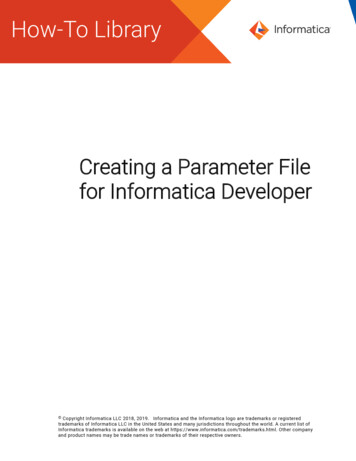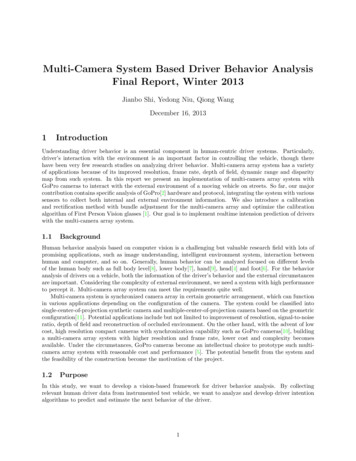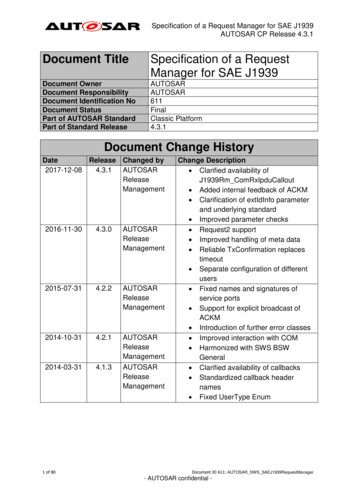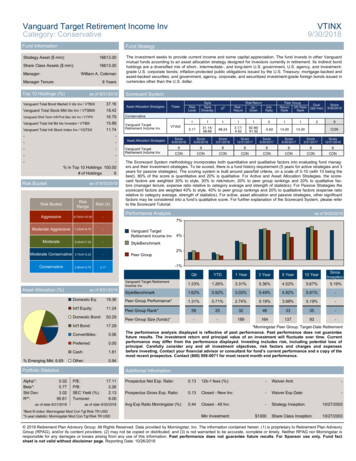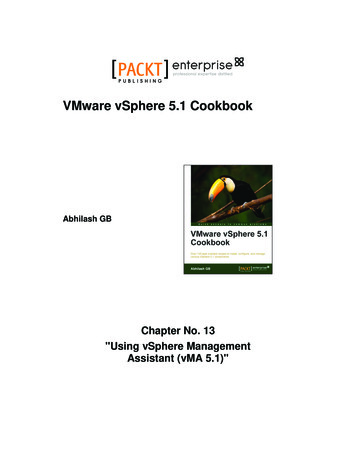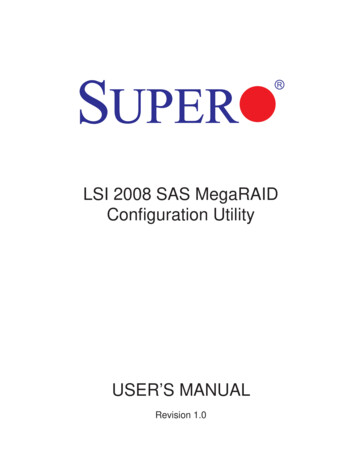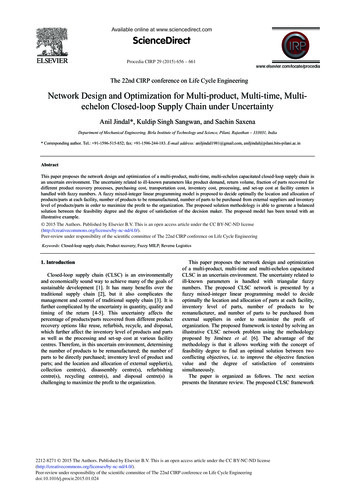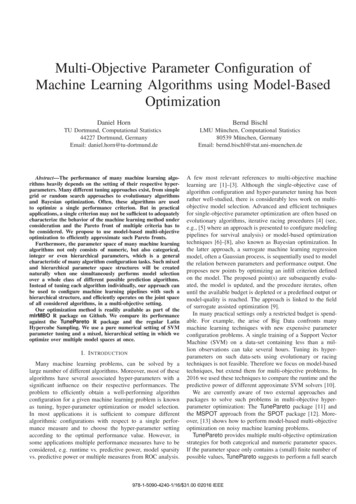
Transcription
Multi-Objective Parameter Configuration ofMachine Learning Algorithms using Model-BasedOptimizationDaniel HornBernd BischlTU Dortmund, Computational Statistics44227 Dortmund, GermanyEmail: daniel.horn@tu-dortmund.deLMU München, Computational Statistics80539 München, GermanyEmail: bernd.bischl@stat.uni-muenchen.deAbstract—The performance of many machine learning algorithms heavily depends on the setting of their respective hyperparameters. Many different tuning approaches exist, from simplegrid or random search approaches to evolutionary algorithmsand Bayesian optimization. Often, these algorithms are usedto optimize a single performance criterion. But in practicalapplications, a single criterion may not be sufficient to adequatelycharacterize the behavior of the machine learning method underconsideration and the Pareto front of multiple criteria has tobe considered. We propose to use model-based multi-objectiveoptimization to efficiently approximate such Pareto fronts.Furthermore, the parameter space of many machine learningalgorithms not only consists of numeric, but also categorical,integer or even hierarchical parameters, which is a generalcharacteristic of many algorithm configuration tasks. Such mixedand hierarchical parameter space structures will be creatednaturally when one simultaneously performs model selectionover a whole class of different possible prediction algorithms.Instead of tuning each algorithm individually, our approach canbe used to configure machine learning pipelines with such ahierarchical structure, and efficiently operates on the joint spaceof all considered algorithms, in a multi-objective setting.Our optimization method is readily available as part of themlrMBO R package on Github. We compare its performanceagainst the TunePareto R package and the regular LatinHypercube Sampling. We use a pure numerical setting of SVMparameter tuning and a mixed, hierarchical setting in which weoptimize over multiple model spaces at once.I. I NTRODUCTIONMany machine learning problems, can be solved by alarge number of different algorithms. Moreover, most of thesealgorithms have several associated hyper-parameters with asignificant influence on their respective performances. Theproblem to efficiently obtain a well-performing algorithmconfiguration for a given machine learning problem is knownas tuning, hyper-parameter optimization or model selection.In most applications it is sufficient to compare differentalgorithmic configurations with respect to a single performance measure and to choose the hyper-parameter settingaccording to the optimal performance value. However, insome applications multiple performance measures have to beconsidered, e.g. runtime vs. predictive power, model sparsityvs. predictive power or multiple measures from ROC analysis.A few most relevant references to multi-objective machinelearning are [1]–[3]. Although the single-objective case ofalgorithm configuration and hyper-parameter tuning has beenrather well-studied, there is considerably less work on multiobjective model selection. Advanced and efficient techniquesfor single-objective parameter optimization are often based onevolutionary algorithms, iterative racing procedures [4] (see,e.g., [5] where an approach is presented to configure modelingpipelines for survival analysis) or model-based optimizationtechniques [6]–[8], also known as Bayesian optimization. Inthe latter approach, a surrogate machine learning regressionmodel, often a Gaussian process, is sequentially used to modelthe relation between parameters and performance output. Oneproposes new points by optimizing an infill criterion definedon the model. The proposed point(s) are subsequently evaluated, the model is updated, and the procedure iterates, oftenuntil the available budget is depleted or a predefined output ormodel-quality is reached. The approach is linked to the fieldof surrogate assisted optimization [9].In many practical settings only a restricted budget is spendable. For example, the arise of Big Data confronts manymachine learning techniques with new expensive parameterconfiguration problems. A single training of a Support VectorMachine (SVM) on a data-set containing less than a million observations can take several hours. Tuning its hyperparameters on such data-sets using evolutionary or racingtechniques is not feasible. Therefore we focus on model-basedtechniques, but extend them for multi-objective problems. In2016 we used these techniques to compare the runtime and thepredictive power of different approximate SVM solvers [10].We are currently aware of two external approaches andpackages to solve such problems in multi-objective hyperparameter optimization: The TunePareto package [11] andthe MSPOT approach from the SPOT package [12]. Moreover, [13] shows how to perform model-based multi-objectiveoptimization on noisy machine learning problems.TunePareto provides multiple multi-objective optimizationstrategies for both categorical and numeric parameter spaces.If the parameter space only contains a (small) finite number ofpossible values, TunePareto suggests to perform a full search978-1-5090-4240-1/16/ 31.00 2016 IEEE
of all possible combinations. In case of larger parameter spacesand numeric parameters, different sampling strategies rangingfrom uniform sampling over latin hypercube sampling towardsquasi-random low-discrepancy sequences can be applied todraw a subset of all possible parameter configurations. Furthermore, for numerical parameter spaces TunePareto provides avariation of the popular NSGA-II [14]. an evolutionary multiobjective optimization algorithm.SPOT (Sequential Parameter Optimization Toolbox) provides different model-based approaches for single-objectiveoptimization, including the handling of categorical parameterspaces. Furthermore a multi-objective method named MSPOTis included. Since [15] shows that MSPOT does not performbetter than competing MBMO algorithms, we will not focuson MSPOT here.Often, normal hyper-parameter tuning is run for each considered machine learning algorithm individually and the bestalgorithm and its configuration are selected at the end. One disadvantage of this approach is that a potentially large amount ofruntime is spent on tuning inferior algorithms. This fact couldhave been automatically learned from the obtained data duringthe optimization much earlier. Current algorithm configurationapproaches like IRACE [4] and SMAC [16] can naturally dealwith this problem, as they allow the optimization over hierarchical parameter spaces. If the configuration problem containsdiscrete choices for the selection of certain methods, specialcategorical selection parameters are introduced that controlwhich method should be used. In our case that might be theselected machine learning algorithm, but it could also refer tothe kernel of an SVM or the applied pre-processing algorithm.The individual methods’ parameters are made dependent onthis choice and are usually called subordinate parameters.This results in a rather complex parameter space, with oftencontinuous, integer, categorical and subordinate parameters.SMAC deals with this problem by giving up the Gaussianprocess as a surrogate model and instead uses a random forest.We follow the same approach here and propose to operate onthe joint parameter space of all learners.We propose to use sequential model-based multi-objectiveoptimization (MBMO) algorithms for parameter configurationproblems. Our contributions in this paper are as follows: We extend the MBMO procedure for mixed and hierarchical parameter spaces. We perform a benchmark study demonstrating thatMBMO algorithms outperform pure sampling and evolutionary multi-objective techniques from the TuneParetopackage for both a standard numerical and a mixedhierarchical parameter space. We present a software framework written in R thatallows a precise definition of the parameter configurationproblem and its optimization using MBMO algorithms.In this paper we will focus on the special case of classification in machine learning. However, all presented methodscan easily be applied to any machine learning tuning problemwhere performance is empirically measurable or even generalalgorithm configuration in arbitrary contexts.In section II we give a general introduction to MBMO andexplain how to use MBMO algorithms in the context of parameter configuration. In section III we conduct two experimentsto compare the performance of our MBMO toolbox againstTunePareto. Section IV demonstrates the usage of our Rimplementation, the paper is concluded in section V.II. M ODEL -BASED M ULTI -O BJECTIVE O PTIMIZATION FORM IXED PARAMETER S PACESMulti-objective (blackbox) optimization refers to an optimization setting with a vector-valued objective functionf (f1 , f2 , . . . , fm ) : X X1 . Xd Rm , with theusual deal that each fi should be minimized. Here, we do not(l)(u)only allow Xi to be numeric, i.e., Xi [xi , xi ] R, but(l)(u)also to be integer (Xi {xi , ., xi } Z) or categorical(1)(s)(Xi {vi , ., vi }).In general, multiple objectives are contradicting, and we areinterested in computing the Pareto front of all possible tradeoffs. A solution x X is said to dominate solution x X if xis at least as good as x in all and strictly better in at least oneobjective. This relation defines only a partial order, allowingthe case of incomparable solutions. The dominance relation issufficiently strong for a definition of optimality: a solution x iscalled Pareto optimal if and only if it is not dominated by any other solution x . The set f (x) x X is Pareto optimalof all non-dominated solutions is called the Pareto front.In the last 10 years many MBMO algorithms have beenproposed. Most of these approaches are based on ideas of thepopular Efficient Global Optimization (EGO) procedure forexpensive black-box optimization [17]. The EGO algorithmworks by sequentially fitting a surrogate regression modelon all so far obtained experimental design points. In eachiteration the model is refitted and optimized with regard toa so-called infill criterion. A new candidate point is proposedand evaluated with the true, expensive objective and the wholeprocedure iterates until a stopping criterion is reached, usuallya constraint on time or number of function evaluation.Two popular MBMO algorithms are ParEGO [18] andSMS-EGO [19]. An overview of alternative MBMO algorithms including their taxonomy is available in [15]. Due tothe general availability of parallel computing power and theadvantages of performing experiments in batches, allowingmore than one point evaluation per sequential iteration (batchprocessing) is of great interest. Especially in context of machine learning with the usage of parallel computing it is easyto evaluate many parameter settings at the same time. As mostMBMO algorithms lack a mechanism to propose more thanone point per iteration, we also proposed multi-point strategiesfor some algorithms, including ParEGO and SMS-EGO [15].Algorithm 1 shows the pseudo code of a general MBMOalgorithm allowing the proposal of multiple points in parallel.First, an initial design of size ninit is evaluated on the actual,expensive objective function. Afterwards a set of l surrogatemodels is fitted on the design. A set of t new candidates isgenerated by optimizing a set of infill criteria based on the
Algorithm 1 Model-based multi-objective optimization.Require: expensive function f : X Rm , batch size t, sizeof initial design ninit , evaluation budget1: generate initial design D : {x1 , .xninit } X2: compute Y : f (D) [f (x1 ), ., f (xninit )]T3: while evaluation budget not exceeded do4: fit surrogate models f̂ {fˆ1 , ., fˆl } on D and Y 5: get {x 1 , ., xt } by optimizing some infill criteria on f̂6: evaluate yi : f (x i ), i 1, ., t 7: D : D {x ,.,x1t}TT8: Y : [Y T , y1 , ., yt ]T9: return Pareto front and set of Y and Dsurrogate models. Finally the new candidates are evaluated onthe real objective function and added to the design.Now we will further explain the cursive components inAlgorithm 1. They can be instantiated to form variants ofMBMO algorithms, as we will demonstrate for ParEGO andSMS-EGO. Moreover, most MBMO algorithms were originally proposed only for numeric parameter spaces. With ourhere proposed adjustments we enable every MBMO algorithmto work on mixed, hierarchical parameter spaces.a) Initial Design: In principle, all available design-ofexperiment techniques can be used. Very often, space fillingtechniques like Latin Hypercube Sampling (LHS) are applied,as we also do for both ParEGO and SMS-EGO here.Since LHS itself is only defined for numeric parameterspaces, it has to be extended towards mixed, hierarchicalparameter spaces. We propose to use a thinning approach,based on distances, to generate an initial design of size ninit :A purely random design of size nexh ninit is sampled andreduced by removing a random point with minimal distanceto another point until only ninit points remain. We use theGower distance function [20] for mixed parameter spaces.b) Surrogate Models: Although any regression modelcould be used, almost all MBMO algorithms use Kriging,including ParEGO and SMS-EGO. Different from EGO,most MBMO algorithms have to fit more than one model periteration since multiple objective have to be taken into account.For example, SMS-EGO fits an individual Kriging model foreach objective function (here: t m).ParEGO follows a different approach. The algorithm fitsa single Kriging model to the scalarized objective functions.This is done by applying the Augmented Tschebbyscheff normwith a uniformly sampled weight vector w. In order to proposea batch of size t, we suggested to sample t different weightvectors per iteration [15] in a stratified manner. New designpoints are selected by optimizing the infill criteria on thedifferent scalarizations separately (here: t l).Kriging itself is defined for numeric parameter spaces only.Although there are several approaches how to generalizeKriging towards mixed parameter spaces (e.g., see [21]), theyare not frequently used. For the single objective case theSMAC toolbox uses a random forest for mixed parameterspaces [16]. A random forest is an intuitive choice since ithas the ability to learn complex non-linear relationships. It alsooffers several possible estimators for the uncertainty of newobservations, which is needed for the calculation of most infillcriteria. One simple approach is to use the standard deviationof the mean proposals of all trees in the forest. We adopt thisidea for the multi-objective case.Due to the possibly hierarchical structure of the parameterspace, some parameters may be inactive for a specific designpoint. We simply treat these inactive values as missing anduse standard missing value imputation techniques to handlethem with the random forest. Since each missing value refersto an area in the parameter space, where the behavior of thetarget function is rather different (since a different methodis used), we replace missing values with values that indicatethis different behavior. Missing values in numeric and integerparameters Xi are replaced by max 2(max min), wheremax and min are the maximal and minimal values of allalready evaluated configurations of Xi . This encodes themissing values outside of the range of normal parameters andtherefore preserves the information that the values were indeedmissing. Missing values in categorical parameters are simplycoded as a new level missing.c) Infill Criterion: Although there are many differentsingle objective infill criteria, only 2 are frequently used:the expected improvement (EI) and the (lower) confidencebound (CB) [6]. Since ParEGO performs a single objective(scalarized) optimization, it can use all of these criteria.Although [18] proposed to use the EI, we showed that it ismore promising to use the CB [15]. In addition to those singleobjective criteria there are several specialized multi-objectiveinfill criteria like the expected hyper-volume improvement[22] and the direct indicator based (DIB) approaches. SMSEGO is one of the DIB approaches: New design points arechosen by maximizing the contribution of their CB-value tothe current Pareto front approximation. The contribution ismeasured using the non-dominated hypervolume.There is no need to adapt the infill criteria to the caseof mixed, hierarchical parameter spaces, since all existingcriteria depend only on the set of surrogate models and thecorresponding uncertainty estimators.d) Infill Optimization: In each iteration of each MBMOalgorithm the respective infill criterion has to be optimized.Since it is cheap to evaluate the infill criterion (it is only basedon model prediction), a large budget of evaluations can beinvested. Therefore the choice of the infill optimizer does notseem critical. Both ParEGO and SMS-EGO use a variantof the CMA-ES [23] for their infill optimization. Since theCMA-ES is not able to handle discrete parameters it has dobe replaced by a more flexible optimizer.In our R-toolbox mlrMBO we use a different approach. Inorder to reduce call stack overhead, it is much more efficientto be able to query model prediction for many different pointsin parallel in each optimizer iteration. Therefore we use anoptimization strategy we call focus search, that calculatespredictions for large chunks of points. Due to its simple andflexible structure, focus search is also able to handle mixed,
Algorithm 2 Infill optimization: focus search.Require: cheap black box function g : X R, number ofrestarts n.restarts, number of focus iterations n.iters,number of random search points n.points1: for u {1, ., n.restarts} do2: Set X : X3: for v {1, ., n.iters} do4:generate random design D X̃ of size n.points5:compute x u,v (x 1 , ., x d ) : arg minx D g(x)6:for X i in X̃ do(l)(u)7:if X̃i numeric: X̃i [x̃i , x̃i ] then(r)(u)(l)8:x̃i : 14 (x̃i x̃i )(l)(l)(l)9:x̃i : max{x̃i , x i x̃i }(u)(u)(u)10:x̃i : min{x̃i , x i x̃i }(1)(s)11:if X̃i categorical: X̃i {ṽi , ., ṽi }, s 2 then12:x̄i : sample uniformly from X̃i \x i13:X̃i : X̃i \x̄i14: Return x : arg ming(x u,v )u {1,.,n.restart},v {1,.,n.iters}hierarchical parameter spaces. The corresponding pseudo codeis given in Algorithm 2. The main idea is an iterated andsequentially refined random search using n.points randompoints. After each of n.iters random search iteration, theconstraints of the feasibility region are focused around thecurrent best point. Due to the stochastic of this procedure andto handle multi-modality of the infill criterion, the procedureis restarted n.restarts times.III. E XPERIMENTSAs an example of multi-objective parameter configuration,we consider the bi-objective minimization of the false-negativeand the false-positive rate (FNR and FPR) in binary classification. We assume that all considered classifiers produce binarylabels in prediction, but can be controlled either via weightingclasses or individual observations, to reweigh preferences forone class or the other. We are interested in computing thecomplete Pareto front in order to obtain the best parametersettings for all potential trades-offs for the two objectives.As a general strategy for balancing FNR and FPR, classweighting can be used. Without loss of generality it is sufficient to adapt the weight ω for the positive class. This isdone by assigning each observation of the positive class theweight ω during model fit, i.e., during the minimization of theloss function, while we assign a weight of 1 to each elementof the negative class. The larger the value of ω, the moreimportance is assigned to observations of the positive class,which in the limit results in an eventual FPR of 1. On theother hand, reducing ω to 0 results eventually in FPR 0.In the first experiment we tune the objectives FNR andFPR of a support vector machine (SVM) with an RBF kernel.We compare the performance of four multi-objective tuningalgorithms on this problem: From the TunePareto R packagewe chose the latin and the evolution strategy. The simpleTABLE ID ESCRIPTION OF THE USED DATA SETS . # OBS IS THE NUMBER OFOBSERVATIONS AND # FEATS IS THE NUMBER OF FEATURES IN THERESPECTIVE DATA SETS . T HE CLASS RATIO GIVES THE PROPORTIONALSIZE OF THE SMALLER CLASS IN COMPARISON TO # OBS , I . E ., A CLASSRATIO OF 0.5 INDICATES THAT BOTH CLASSES ARE OF EQUAL SIZE . T HEDID IS THE UNIQUE DATA SET IDENTIFIER ON THE O PEN ML PLATFORM .nameada agnosticeeg-eye-statekdd waveform#obs4 56214 9809 96115 54510 9925 4044 6016 5745 000#feats4814145165571440class 7197610461019148944847979latin strategy performs LHS sampling. The more advancedevolution strategy is based on the well-known NSGA-IIapproach, but adapts both the recombination and the mutationstrategy (see [11] for more details). From our toolbox mlrMBOwe chose SMS-EGO and ParEGO fused with the CB infillcriterion. SMS-EGO is run in its sequential variant whileParEGO is forced to propose 4 points in each iteration. Theadvantage here is that all 4 points can be evaluated in paralleland the algorithm can gain a theoretical speed up of factor 4.In the second experiment we optimize a joint parameterspace of three base learners: an SVM, a random forest and aregularized logistic regression. Unfortunately TunePareto isnot able to handle such complex parameter spaces, thereforewe are only able to use ParEGO and SMS-EGO. As abaseline we also run a simple latin hypercube sampling.We run the experiments on several data sets (see table I), allof them are available on the open machine learning platformOpenML [24]. To obtain a bearable overall execution time forour experiments, we decided to use only mediocre sized datasets. However, we think that the results can be transferred tolarger data-sets. FNR and FPR are measured by 10-fold crossvalidations. For an unbiased estimation of the Pareto front weuse a nested resampling strategy: The tuning is performed ononly 50% of the data points, the remaining 50% are usedfor a-posteriori test evaluation. In this paper we only reportmeasures based on the test evaluations.We perform 10 replications per algorithm and data set.Each tuning algorithm is presented the same cross-validationsplits for each statistical replication. To analyze our results wenormalize the resulting decision vectors Ỹ [y1T , ., ynT ]T ,where Ỹ is the union over the results of all algorithms foreach data set and replication. We apply the transformationyi min yimax yi min yi , so that the corresponding Pareto front of eachobjective and replication has the range [0, 1]. We then computethe dominated hypervolume (with reference point (1.1, 1.1))and the 50% empirical attainment function (eaf) [25] for allalgorithms and data sets. To compare the performances ofthe various algorithms we folow the procedure proposed byDemsar [26]. We perform Friedman tests to detect significantdifferences in the performances followed by post-hoc Nemenyi
TABLE IITHE PAIRED PAIRWISE T-T ESTS (α 0.05) FOR THE SVMEXPERIMENT. INDICATES THE FIRST, - THE SECOND ALGORITHM WASSIGNIFICANT BETTER , OTHERWISE 0 IS DISPLAYED . T HE F RIEDMAN TESTFOR EQUAL MEDIAN HYPERVOLUME VALUES REJECTED ITS NULLHYPOTHESES WITH AN P - VALUE OF 0.001, THE LAST LINE OF THE TABLESHOWS THE P - VALUES OF THE POST- HOC N EMENYI TESTS .SMS-EGO vslatinSMS-EGO vsevolutionParEGO vslatinParEGO vsevolutionlatin vsevolutionads agnosticeeg-eye-statekdd windp-ValueSMS-EGO vsParEGOR ESULTS OF 00000000.885 0 0.003 0 0.031 00 0.031 00 0 0.185 0000 0.885tests. For further insight into the data we do also performpairwise Wilcoxon tests with paired samples. All tests areperformed with significance level α 0.05.The experiments are conducted using our own softwarepackages written in R [27], including (but not only) mlrMBO[28], mlr [29] and BatchExperiments [30] and were executedon the LiDOng cluster of TU Dortmund university.A. Tuning a support vector machineWe tune an SVM with RBF kernel, i.e., we optimize thecost parameter C, the inverse kernel width γ and the classweighting parameter ω (d 3). The region-of-interest for Cand γ is defined as 2[ 15,15] , for ω we use the interval 2[ 7,7] .All parameters are optimized on a logarithmic scale.We consider a total budget of 160 ( 50d) functionevaluations. For both ParEGO and SMS-EGO we use thesame random LHS as initial design with size 30 ( 10d).As surrogate we use a Kriging model with matern- 23 kerneland a small nugget effect (10 4 ) for numerical stability. Weforce ParEGO to propose 4 points in each iteration, SMSEGO is run in its sequential variant. For our focus searchwe set n.iters n.restarts 3 and n.points 1000. ForTunePareto’s evolution-strategy we set μ λ 20.The results are shown in the left columns of both Fig.2 and Fig. 3. On all test functions both SMS-EGO andParEGO are at least as good as latin and evolution, mosttimes both MBMO algorithms outperform both baselines. Theboxplots show higher hypervolume values on nearly all datasets, the median eaf-plots do confirm the hypervolume values.It appears to be difficult to give a ranking between the twoMBMO algorithms, only on the wind data set we observe thatParEGO performs better than SMS-EGO. The differencesbetween latin and evolution are much clearer on some datasets, but since they take turns in dominating each other it isalso impossible to state a winner here.The Friedman test gives a p-value of 0.001, therefore wehave a strong indicator that the differences in the figures aresignificant. In table II the results of the post-hoc Nemenyi testsand the paired Wilcoxon tests are shown. The tests mainlyconfirm the impression we got from the figures, but herethe results are even more distinct. Apparently some variancecaused by the different resampling instances was eliminatedin the pairing process. Both ParEGO and SMS-EGO are notsignificantly worse than the baselines on all 9 test functions,and they are significantly better on 6 to 8 test functions.However, the Nemenyi test does not show a significant difference between ParEGO and evolution. Comparing SMS-EGOand ParEGO the Nemenyi test does not show a significantdifference, only on 2 data sets differences were detected bythe Wilcoxon test. Comparing latin and evolution we see 3wins for latin, 2 wins for evolution and 4 draws. In this case,the Nemenyi test does also not find a significant difference.Overall we can state that both MBMO algorithms outperform the baselines from the TunePareto package. AlthoughParEGO was forced to propose 4 points in each iteration,which should be a disadvantage in the optimization (new information is not included every single, but every 4th iteration),it was able to reach the same performance as SMS-EGO.B. Tuning over multiple models with hierarchical structureNow we consider a joint model space containing three baselearners: an SVM, a random forest and an L2-regularized logistic regression. The hierarchical structure of the corresponding parameter set (containing numeric, integer and discreteparameters) is displayed in Fig. 1. Note that most parametersare dependent on the discrete parameter learner.We try to use almost the same settings as in the firstexperiment. However, to handle the mixed parameter spaces,some changes have to be done: to accurately sample thelarger parameter space we increased the size of the initialdesign to 60 and the overall budget to 300 points. This where d 6 is the number ofcorresponds to 10d and 50d,numeric and integer parameters in X . We use our thinningXω2[ 7,7]random forestlearnerL2 LogRegsvmkernelradialmtrynodesizeClinearCγ{ 0.1p , ., 0.9p }{1, ., 0.5n }{1, ., 21}2[ 15,15]2[ 15,15]Fig. 1. Joint parameter space of the second experiment. Circles denote variables, rectangles denote values of numerical and discrete parameters, arrowsdenote the hierarchic structure. Here n denotes the number of observations,p the number of features in the respective data set.
MAlgorithmeraral1.0ada agnostic1.100.91.050.81.000.70.950.6ParEGOeeg eye d 200.150.500.100.250.150.000.25 1.20SMS .081.051.151.110.81.090.6latinParEGOFig. 2. Hypervolume values for both experiments and all data .1SMS EGOevolutionlatinParEGO0.30.10.4SMS 0.30.00.20.40.6Fig. 3. 50% empirical attainment functions of the two objectives FNR andFPR for both experiments, the axis limits were focused on the interestingparts of the Pareto fronts. The order of the data sets is the same as in Fig. 2.
SMS-EGO vslatinParEGO vslatinada agnosticeeg-eye-statekdd formwindp-ValueSMS-EGO vsParEGOTABLE IIIR ESULTS OF THE PAIRED PAIRWISE W ILCOXON TESTS (α 0.05) FORTHE JOINED SPACE EXPERIMENT. INDICATES THE FIRST, - THE SECONDALGORITHM WAS SIGNIFICANT BETTER , OTHERWISE 0 IS DISPLAYED . T HEF RIEDMAN TEST FOR EQUAL MEDIAN HYPERVOLUME VALUES REJECTEDITS NULL HYPOTHESES WITH AN P - VALUE OF 0.0006, THE LAST LINE OFTHE TABLE SHOWS THE P - VALUES OF THE POST- HOC N EMENYI TESTS .0 000 0.466 00 0.026approach as initial design with an
Machine Learning Algorithms using Model-Based Optimization Daniel Horn TU Dortmund, Computational Statistics 44227 Dortmund, Germany Email: daniel.horn@tu-dortmund.de Bernd Bischl LMU M unchen, Computational Statistics 80539 M unchen, Germany Email: bernd.bischl@stat.uni-muenchen.de Abstract—The performance of many machine learning algo-
